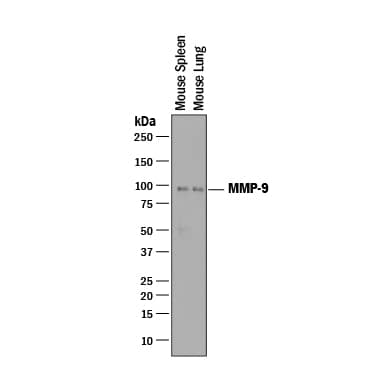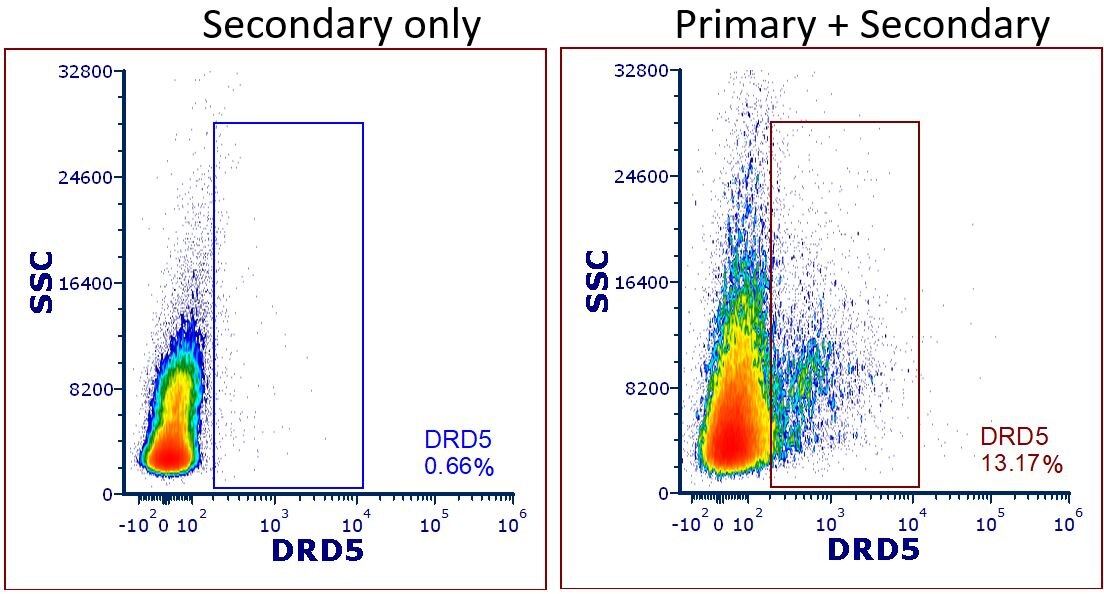Human Dopamine D5R/DRD5 Antibody Summary
Met1-His477
Accession # P21918
Customers also Viewed
Applications
Please Note: Optimal dilutions should be determined by each laboratory for each application. General Protocols are available in the Technical Information section on our website.
Scientific Data
 View Larger
View Larger
Detection of Dopamine D5 R/DRD5 in HEK293 Human Cell Line Transfected with Human Dopamine D5 R/DRD5 and eGFP by Flow Cytometry. HEK293 human embryonic kidney cell line transfected with either (A) human Dopamine D5 R/DRD5 or (B) irrelevant transfectants and eGFP was stained with Mouse Anti-Human Dopamine D5 R/DRD5 Monoclonal Antibody (Catalog # MAB82861) followed by Allophycocyanin-conjugated Anti-Mouse IgG Secondary Antibody (Catalog # F0101B). Quadrant markers were set based on control antibody staining (Catalog # MAB003).
Preparation and Storage
- 12 months from date of receipt, -20 to -70 °C as supplied.
- 1 month, 2 to 8 °C under sterile conditions after reconstitution.
- 6 months, -20 to -70 °C under sterile conditions after reconstitution.
Background: Dopamine D5R/DRD5
DRD5, also known as Dopamine D5 Receptor has a higher affinity for neurotransmitter dopamine than DRD1 (1). DRD5 is expressed in neurons in many human brain regions, including cortex regions, hippocampus, choroid plexus, and brainstem (2). Polymorphisms in the DRD5 gene have been associated with Attention Deficit Hyperactivity Disorder (ADHD) (3), schizopherenia (4) and nicotine dependence (5). Dopamine receptors undergo endocytosis upon interaction with receptor agonists and by activation of Protein Kinase C (PKC) (6).
- Sunahra, R. et al. (1991) Nature. 350:614.
- Weinshank, R. et al. (1991) J Biol Chem. 266:22427.
- Squassina, A. et al. (2008) Neurosci Lett. Feb 13.
- Golimbet, V. et al. (2008) Bull Exp Biol Med. Jan.
- Wei, J. et al. (2012) Addict Behav. 37:622.
- Thompson, D. et al. (2011) Traffic. 12:644.
Product Datasheets
FAQs
No product specific FAQs exist for this product, however you may
View all Antibody FAQsIsotype Controls
Reconstitution Buffers
Secondary Antibodies
Reviews for Human Dopamine D5R/DRD5 Antibody
Average Rating: 4 (Based on 2 Reviews)
Have you used Human Dopamine D5R/DRD5 Antibody?
Submit a review and receive an Amazon gift card.
$25/€18/£15/$25CAN/¥75 Yuan/¥2500 Yen for a review with an image
$10/€7/£6/$10 CAD/¥70 Yuan/¥1110 Yen for a review without an image
Filter by:
Whole blood was diluted with PBS, overlaid atop Ficoll, and centrifuged to separate the PBMC layer. The PBMC layer was washed twice with PBS and cells were aliquoted into centrifuge tubes for staining. Cells were counted and concentration was adjusted to 10,000 cells per uL. 100 uL of cells was aliquoted into each centrifuge tube for surface staining.
1uL of anti-DRD5 antibody was added to the 'primary + secondary' condition. Cells were incubated on ice for 30 mins protected from light. Following incubation, cells were washed twice with PBS and then fixed at room temperature for 30 mins protected from light. Cells were washed twice with permeabilization buffer and resuspended in 100 uL perm buffer for secondary staining. 1uL of secondary antibody (R&D systems, Cat#F0102B) was added to both the 'secondary only' and 'primary + secondary' condition. Cells were incubated at room temperature for 30 mins protected from light. Following 2x perm buffer washes, cells were resuspended in 500uL PBS for flow cytometry acquisition.
'Secondary only' condition (left) was used to determine the gate placement .'Primary + secondary' condition (right) shows successful flow cytometry staining for DRD5 in total PBMC fraction.
We transfected HEK cells with a DRD5 plasmid and stained them for DRD5 at a 1:1000 concentration. Secondary only and parental HEK cells were used as controls to confirm specific staining.

















